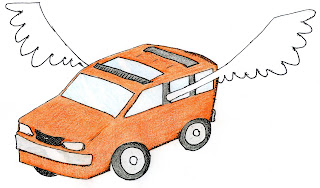Bar bet: which will any normal person be able to buy first: flying car or car that drives itself? Well, right now you can buy a Ford Focus, that's right, a Ford Focus that can parallel park itself, while the driver just has to hold the brake pedal. So, unless you count doing seventy-five through New Orleans City Park and catching air on the bridges over the bayou, self-driving car is well in the lead.
Car fatalities have gone down per mile travelled every year they've been measured. Most years they go down as an absolute number. Cars are safer; they handle and brake better, and they protect their passengers better in a crash. Car makers and regulators both know that the leading, actually almost the only cause of auto accidents is the driver.
Active and Passive Safety
There are two types of safety features in the automotive world: active and passive.
Passive safety features help protect the passengers from injury in the event of a crash: Seat belts, airbags, deformable zones in front and rear, safety cell construction around the passenger compartment, are all examples of passive safety features.
Active safety features; which can be as simple as rearview mirrors, turn signals and headlights; help prevent an accident. In 1972, the Chrysler Imperial became the first car to introduce four-wheel electronic antilock brakes. At $500, it's unknown how many of this new optional feature were sold, but they didn't remain on the option sheet long.
In August 1978 Mercedes and Bosch reintroduced ABS. By the late 1980's they were offered as optional or standard equipment on a wide range of automobiles. These systems allowed a car to stop shorter, while maintaining control. For the first time a driver could panic stop and steer the car even on slippery roads.
ABS Doesn't Prevent Accidents
Stability Control Does
Electronic Stability Control is so effective, the U.S. made it mandatory for all new vehicles for the 2011 model year.
What's Now?
Cars Helping
- Turn your headlights on and off for you. (1960)
- Turn your high-beams on and off as others vehicles are detected. (1952)
- Turn the headlight beams in the direction the car is turning. (1948)
- Turn your wipers on and off for you as it rains.
- Detect the distance to vehicles in front and automatically keep a safe following distance. (1995)
- Detect a stopped vehicle or obstruction ahead and warn the driver with flashing lights and chimes.
- Determine that an collision with an object in front is imminent and automatically apply the brakes.
- Detect a drowsy, inattentive driver and warn him with a chime and warning light to suggest a break.
- Show the driver what's in his blind spot using video cameras and an in-dash display.
 |
| 2013 Honda Accord LaneWatch Monitor |
- Determine that an object is in the vehicle's blind spot and warn the driver with a light.
- Sense that the driver is going to possibly collide with a vehicle in his blind spot and flash a warning, sound a chime, vibrate the steering wheel or vibrate the driver's seat to warn him.
- Determine that the driver is imminently in danger of colliding with a vehicle in his blind spot and automatically steer the vehicle back into its original lane. (2010)
- Warn the driver he is drifting out of his lane. (2004)
- Steer the car back into its lane if it drifts out.
- Warn you when you're about to hit something as you back up.
- Automatically brake your vehicle while you back up if you are going to hit something.
- Warn you if a car is coming at you from the side as you back up.
- Alert you if somebody is waiting in your parked car.
- Alert you if you leave a child in your car when you're leaving your car.
- Parallel park your car for you, with you only operating the brake and gas.
- Show the driver, on a display, possible pedestrians or wildlife in the road or by the side of the road not generally visible using infrared lights and cameras or radar.
What's Next?
Cars Chatting
What's Coming Further Down the Road?
Cars Driving








